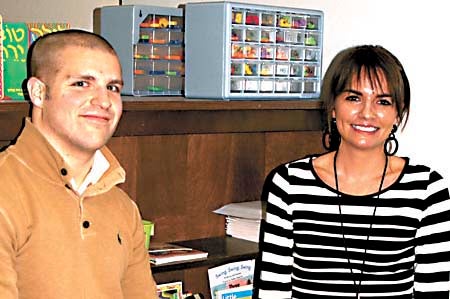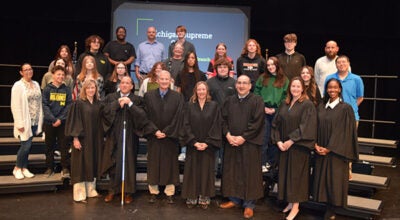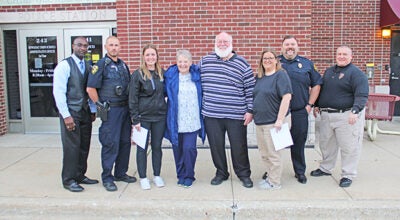Intervention boosts literacy
Published 10:09 pm Tuesday, March 19, 2013

Patrick Hamilton first grade teacher Jon Leazenby and Justus Gage Title I teacher Tennille Smith with books divided into “levels” by reading difficulty in the Reading Recovery hub at Patrick Hamilton.
Reading Recovery is a short-term intervention of one-to-one tutoring for low-achieving first-graders.
It serves the lowest-achieving first-graders who are not catching on to the complex set of concepts that make reading and writing possible.
Individual students receive a half-hour lesson each school day for 20 weeks with a specially trained teacher.
As soon as students can meet grade-level expectations and demonstrate they can continue to work independently in the classroom, their lessons discontinue and a new wave of students begin individual instruction.
“It’s important for us to step outside the box and teach other strategies because certain kids learn different ways,” Justus Gage Title I teacher Tennille Smith said.
Phonics is still a way of sounding out words, but to that visual source of information they add meaning (figuring out what’s going on in a story) and structure (grammar).
“It’s comprehensive,” Patrick Hamilton first-grade teacher Jon Leazenby said. “It’s literacy, not just reading. Reading and writing are like a left hand and a right hand. Our goal is to accelerate someone below grade level to grade level by the end of our intervention.”
Phonics can be a hurdle for the worst readers, but because they struggle so much, they might be good at meaning — “looking at pictures and thinking about what’s happening in a story,” Leazenby said. “You play on that to help them by shoring up their weaknesses” and building on whatever strengths they possess.
Smith, who works with grades K-5 in the morning and four Reading Recovery students in the afternoon, is also able to see it from a parent’s perspective.
“My son was in it as a student in first grade at Justus Gage,” she said. “He’s in fourth grade now. He may never be one of those kids who reads on a Sunday afternoon for fun, but he’s able to ace his tests and read his textbooks. That’s why I’m a big advocate. It’s amazing to see where the kids I worked with in the first wave ended up. They were at the bottom, and now they’re right in the mix of average students. Once they can read, they’re going to excel in all subjects.”
“We try to get them before they form bad habits,” said Leazenby, who provides literacy support to two of his students after lunch each afternoon while a rotating substitute executes his math lesson plans. “It’s pre-emptive. These are tools they can use to figure out unknowns. That’s what good readers do. I had one in first wave who was reading at level three. He was reading at level 20 by 15 weeks. We don’t use strategies in isolation, but combine them in orchestration.”
Reading Recovery, which began in New Zealand, landed in the United States in 1984.
It came to Dowagiac in 2008 at Kincheloe with first-grade teacher Christa Siegel and last year made a big leap to becoming a training site with teachers coming from as far away as Zeeland for instruction.
The districtwide elementary hub is at Patrick Hamilton Elementary School.
“If I lived in Southwest Michigan, Dowagiac would be the place to send your child because they can be assured their child is going to learn to read,” Supt. Dr. Mark Daniel said.
Forty students, determined to be in the bottom 30 percent by a six-part evaluation, received literacy support from 15 teachers districtwide in the “first wave” of 2012-2013.
Follow-up studies indicate most Reading Recovery students also do well on standardized tests and maintain their gains in later years.
The few students still having difficulty after a complete intervention are recommended for further evaluation, such as classroom support, Title I or groups of three with a teacher.
Dowagiac commits a combination of federal, state at-risk and local funds to Reading Recovery. General funds support graduate-level coursework offered through Oakland University.
Katrina Daiga, who taught first grade for the district for 10 years before switching exclusively to Reading Recovery in August 2011, showed Dowagiac Board of Education March 18 the strides students made.
To build vocabulary, students write as many words as they can in 10 minutes.
“The average for the district was 11,” said Daiga, the teacher leader in training other educators — one of 13 in Michigan — “and the outcome at the end was 37. We’ll present again in June to show the full-year outcome.”
Two Justus Gage teachers also addressed the school board.
“I believe this program is a huge benefit to our students,” Melissa Maiers said. “I’ve seen students who began at level one become more confident in writing and reading. I have a student with 55 lessons at level 14 and able to write sentences that look and sound right.”
Sarah Proctor, who teaches second grade, said, “I’m excited! Students I work with have made a lot of progress. Even more important is the relationships they build. They didn’t want to look at pages. Now they’re excited to come to school, which is so exciting for me as a teacher. I won’t lie. It’s been a lot of work, but it’s worth it. Next year, first-graders coming into my grade are going to be so much better prepared and ready to learn.”






